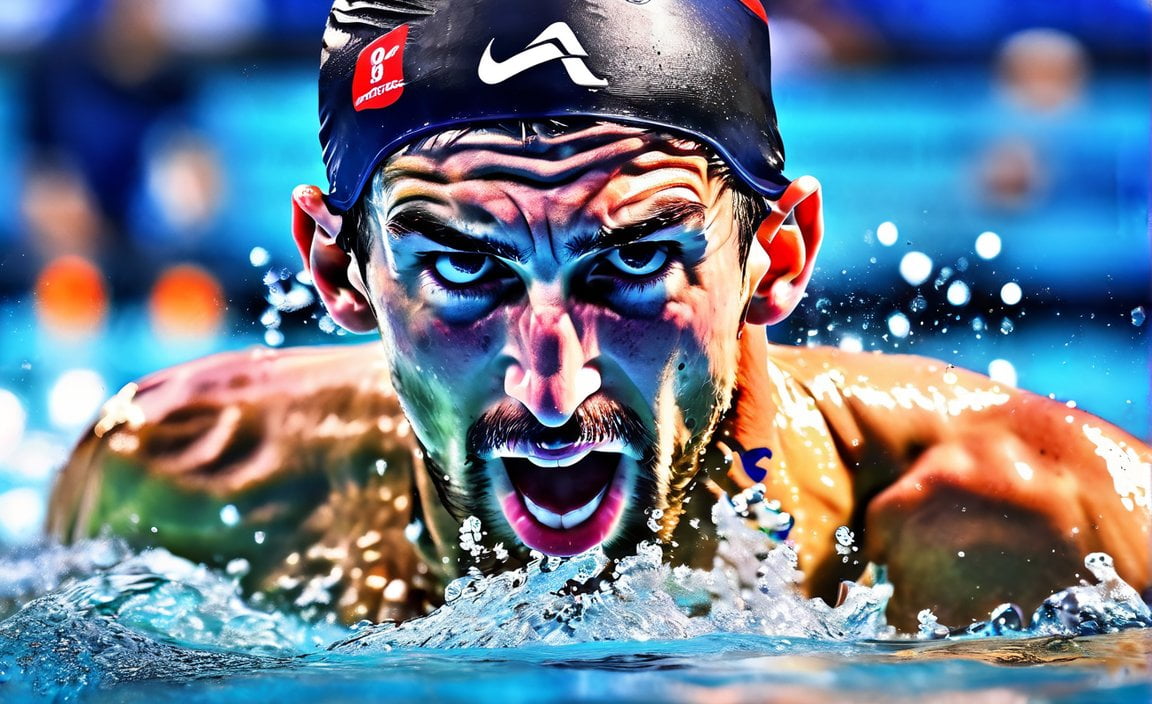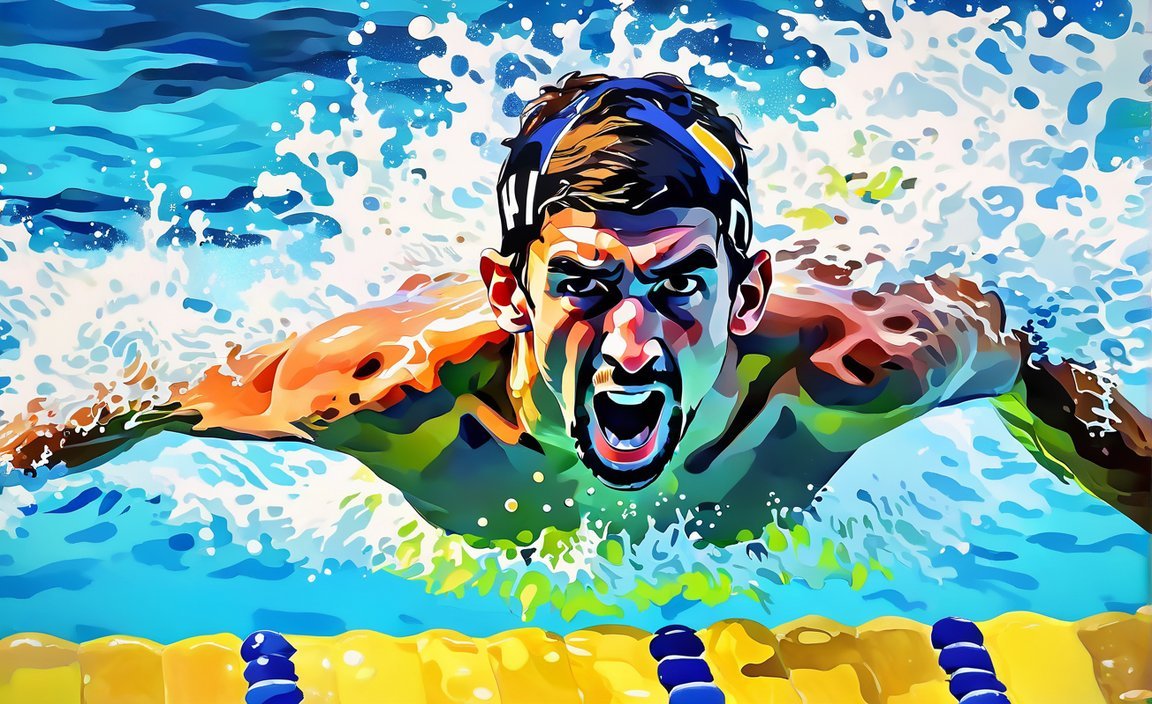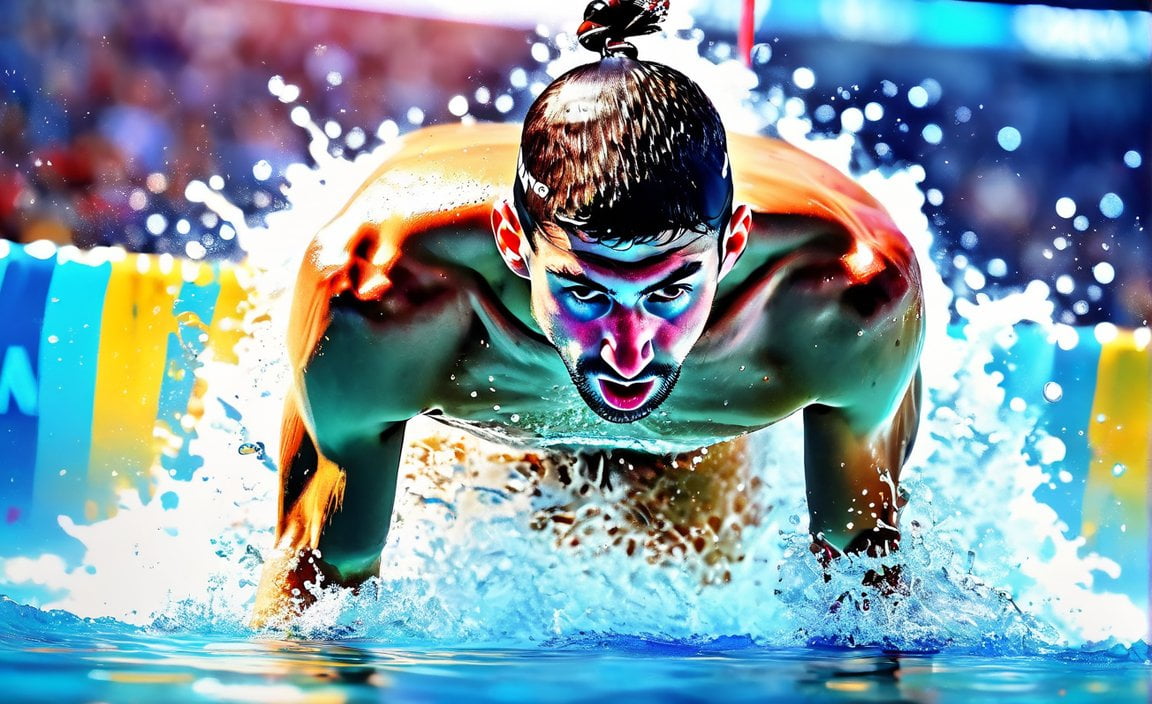We all know Michael Phelps as the swimming sensation with more Olympic medals than anyone could have imagined. But did you know he also made time for higher education? That’s right, even with a schedule packed with chlorine and butterfly kicks, Phelps pursued academics, demonstrating that chasing gold medals and a diploma don’t have to be mutually exclusive.
Michael Phelps College: Balancing Books and Butterfly Strokes
While the school Phelps attended wasn’t named after him (imagine that!), it played a pivotal role in his journey. The University of Michigan became his academic pool, where he honed his mind alongside his physical prowess. Under the guidance of legendary coach Bob Bowman, Phelps found a balance between rigorous training and the demands of college life.

This means that he was smashing world records and racking up NCAA championships, all while maintaining a respectable GPA. So how did he do it? The university deserves credit for understanding that Phelps, as a rare student-athlete, needed flexibility and support. Michigan provided him with the resources to tailor a schedule that accommodated his unique circumstances.
Now, you might be thinking, “Okay, but Phelps is one-of-a-kind. This doesn’t apply to me.” And you’d be right; there’s only one Michael Phelps. But his story offers a powerful lesson for any aspiring student-athlete. It demonstrates that you don’t have to choose between your passion and your education. Phelps proved that dedication and the right support system enable individuals to strive for greatness in all aspects of life.
This message resonates beyond the pool. Phelps’ time at Michigan equipped him with more than just a degree; it equipped him with the skills to navigate life beyond the Olympics. He learned to advocate for children’s health, launch his own swimwear line, and even dive into the world of business.
Phelps’ story reminds us that success has many facets. It’s about finding an environment that understands and supports your aspirations, both inside and outside the classroom.
What Did Michael Phelps Go to College For?
In 2004, Olympic superstar Michael Phelps decided to become a Wolverine, enrolling at the University of Michigan. This was a significant decision considering Michigan’s renowned academic and athletic programs.
Phelps’ choice to pursue higher education alongside his demanding training schedule highlights his understanding of education’s importance, even amidst his swimming success. It suggests he recognized that life extended beyond swimming laps, and he sought to broaden his horizons, embrace new challenges, and become a well-rounded individual.
Key Takeaways:
- Education remained a priority for Phelps despite his Olympic success.
- He chose the University of Michigan for his academic pursuits.
- Balancing training and college required dedication, but Phelps committed to both.
- His decision implies he recognized the value of education beyond athletics.
To delve deeper into Michael Phelps’ motivations and initiatives: Visit the Michael Phelps Foundation website.
Key Lines:
- Michael Phelps attended the University of Michigan but did not participate in their swim team due to his existing professional endorsement with Speedo.
- Phelps has been coached by Bob Bowman since he was a young swimmer, and Bowman also served as his coach at Michigan.
- Phelps began swimming at a young age and was breaking records by the age of 10, qualifying for the 2000 Olympics at just 15 years old.
- After retiring from swimming, Phelps established the Michael Phelps Foundation to promote swimming and healthy lifestyles.
Is Michael Phelps a Millionaire?
With 28 Olympic medals (including 23 gold!), Michael Phelps has become a swimming legend. His victories have earned him an estimated $1.9 million in prize money, with the medals themselves valued at around $640,000.
However, Phelps’ true wealth comes from endorsements and business ventures. His partnerships with major brands like Speedo, Subway, and Kellogg’s, along with his own swimwear company, MP Swim, have significantly contributed to his estimated net worth of $80 million.
Beyond his financial success, Phelps has also focused on giving back through his Michael Phelps Foundation. His story demonstrates that athletic talent, combined with smart business decisions and a dedication to philanthropy, can lead to remarkable achievements.
How Old Was Michael Phelps When He Went to the Olympics?
At the young age of 15, Michael Phelps made his Olympic debut at the 2000 Sydney Games, becoming the youngest American male to qualify for the Olympic team in almost 70 years. Although he didn’t medal that year (placing fifth in the 200m butterfly), his potential was evident.
Phelps’ early success can be attributed to his dedication and the guidance of his coach, Bob Bowman. Bowman’s demanding training program pushed Phelps to his limits, developing his strength, endurance, and mental fortitude.
His hard work culminated in a historic performance at the 2008 Beijing Olympics, where he won a record-breaking eight gold medals, solidifying his status as a swimming legend.
Key Takeaways:
- Michael Phelps was only 15 when he first competed in the Olympics.
- His coach, Bob Bowman, played a significant role in his development.
- Phelps made history at the 2008 Beijing Olympics by winning eight gold medals.
- He now gives back to the sport through the Michael Phelps Foundation.
How Fast Was Michael Phelps at 12?
While finding his exact times at 12 might be difficult, we can get an idea of his potential by looking at his accomplishments just a few years later. At 15, Phelps qualified for the U.S. Olympic team, a rare feat that speaks volumes about his abilities at that age.
Several factors contributed to his early success. His natural talent was undeniable – he had the physique of a swimmer, with long arms, a long torso, and possibly even double-jointed ankles. This, combined with his relentless drive and rigorous training under Bob Bowman, set him on a path to greatness.
Phelps’ commitment was evident in every aspect of his life, including his diet. He reportedly consumed up to 12,000 calories a day to fuel his intense training.
While we may never know his exact speed at 12, it’s clear that the signs of a champion were already there. His journey from prodigy to Olympic icon is a testament to the power of dedication and hard work.
What Famous Swimmer Has ADHD?
Olympic champion Michael Phelps was diagnosed with ADHD as a child. For Phelps, swimming became a sanctuary, a way to channel his energy and manage his ADHD symptoms. His mother, a pillar of support, recognized the positive impact swimming had on him.
Phelps credits some of his success to traits associated with ADHD, such as his laser-like focus and competitive drive. He believes these qualities helped him stay motivated during grueling training sessions and high-pressure competitions.
Today, Phelps is a vocal advocate for ADHD awareness. He shares his story to inspire others and demonstrate that ADHD is not a limitation but a different path to success.
What is Michael Phelps’ Salary?
Michael Phelps has an estimated net worth of $100 million. His swimming career brings in an estimated $9.3 million annually, and his endorsements bring in another $10 million each year. His 28 Olympic medals, including 23 gold, have opened numerous doors to lucrative opportunities.
Phelps is also a successful businessman, with ventures in various industries, further contributing to his wealth. Despite his success, he remains committed to giving back through his Michael Phelps Foundation, which encourages children to swim and promotes healthy lifestyles.
Key Takeaways:
- Michael Phelps’ estimated net worth is $100 million.
- He earns around $9.3 million annually from swimming and $10 million from endorsements.
- He is the most decorated Olympian of all time, with 28 Olympic medals, including 23 gold.
- Beyond swimming, Phelps is an entrepreneur with ventures in various industries.
- He founded the Michael Phelps Foundation to encourage children to swim and live healthier lives.
What Did Michael Phelps Do for a Living?
For over 20 years, Michael Phelps dominated the world of swimming, earning an astounding 28 Olympic medals, including 23 gold. He is considered one of the greatest Olympians of all time.
Since retiring from competitive swimming in 2016, Phelps has worked as an NBC Sports commentator, sharing his expertise and insights during swimming events.
Phelps is also passionate about promoting swimming and healthy lifestyles, especially among children. He founded the Michael Phelps Foundation to achieve these goals, focusing on water safety, healthy habits, and encouraging youth involvement in swimming.
Was Michael Phelps a Good Swimmer as a Kid?
Michael Phelps wasn’t just a good swimmer as a kid; he was exceptional. At 10 years old, he was setting national age-group records. By 15, he was competing in the Olympics.
His success stemmed from a combination of factors, including his natural talent, dedication, and rigorous training under Bob Bowman. Phelps’ long arms and torso, along with his exceptional lung capacity, gave him a physical advantage. However, it was his unwavering work ethic and the intense training regimen implemented by Bowman that truly set him apart.
Interestingly, Phelps’ ADHD might have played a role in his success. Swimming provided an outlet for his excess energy, while his ability to hyperfocus, a common trait associated with ADHD, likely helped him maintain concentration during training and competitions.
Phelps’ story is a testament to the power of dedication, resilience, and embracing one’s uniqueness.
How Did Michael Phelps Prepare Himself to Become an Olympic Champion?
Michael Phelps’ journey to becoming an Olympic champion was a combination of natural talent, unwavering dedication, and the support of a dedicated team.
The Drive that Pushed Him Further
From a young age, Phelps possessed an exceptional drive to be the best. He combined this natural determination with an understanding that achieving his goals required more than just talent.
Training Like There’s No Finish Line
Phelps committed to a training schedule that most would find grueling. He spent countless hours in the pool, refining his technique and pushing his physical limits under the watchful eye of his coach, Bob Bowman.
Behind Every Champion, There’s a Support System
Phelps’ family played a crucial role in his journey. His sisters sparked his love for swimming, and his parents provided unwavering support. This network of support provided him with the strength to persevere through challenges.
Fueling the Phenomenon: Food and Recovery
Phelps understood the importance of proper nutrition. His diet consisted of around 12,000 calories a day, providing his body with the fuel it needed to sustain his intense training regimen. He also prioritized recovery, incorporating methods like ice baths and acupuncture to optimize his performance.
The Mind of a Champion: Overcoming Obstacles
Phelps encountered setbacks throughout his career, but he learned from these experiences and used them as motivation. He understood that the ability to overcome adversity is what separates the good from the great.
The Takeaway: A Legacy Built on Dedication
Michael Phelps’ journey exemplifies the power of dedication, pushing boundaries, and maintaining an unwavering belief in oneself. His story serves as an inspiration to aspiring athletes and a testament to what can be achieved through hard work and commitment.

What is the Science Behind Michael Phelps?
Michael Phelps’ dominance in swimming can be attributed to a combination of factors, including his physical attributes, training methods, diet, and mental fortitude.
Built Like a Fish, Almost!
Phelps possesses a physique naturally suited for swimming. His long, lean body, extensive wingspan, and large feet provide him with an advantage in the water. These physical characteristics, combined with his likely high percentage of fast-twitch muscle fibers and exceptional cardiovascular system, allow him to generate power and maintain endurance.
Training Like It’s a Science Experiment
Phelps’ training, developed with his coach Bob Bowman, was innovative and demanding. They used technology to analyze and optimize his stroke technique, incorporating weightlifting and dryland exercises to develop his overall strength and stamina.
Fueling the Phelps Machine
To sustain his intense training, Phelps consumed a legendary diet of up to 12,000 calories a day. His meals were carefully planned to provide him with the carbohydrates, lean proteins, and essential nutrients needed for optimal performance and recovery.
The Mind of a Champion
Phelps’ mental strength is as impressive as his physical abilities. He practiced visualization, positive self-talk, and worked with sports psychologists to enhance his mental game. He understood that winning requires both physical and mental toughness.
The Takeaway
Michael Phelps’ success story demonstrates the remarkable achievements possible when natural talent is nurtured with scientific training, meticulous nutrition, and an unwavering mindset.
- How many feet is 300 meters? 984 Feet: Understand Length Conversions Easily - March 31, 2025
- Senior at What Age: Benefits & Eligibility Guide - March 29, 2025
- Unlocking Senior Benefits: How Old is a Senior? Your Complete Guide - March 29, 2025
















